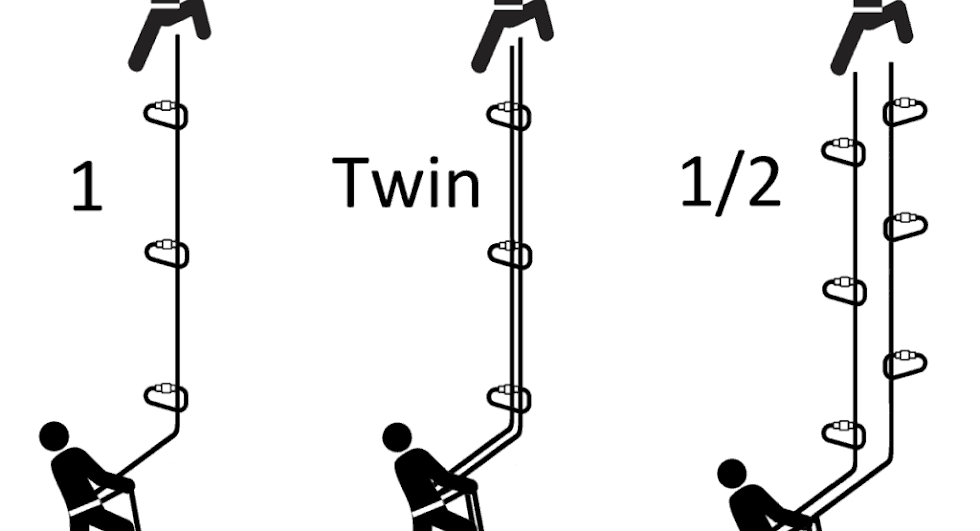I try to use double ropes/ half ropes as much as possible when I’m climbing trad routes unless I’m climbing at a very small crag like Ballyryan.
If you’re not used to using them, they might seem like an extra faff and for new climbers, there’s a cost factor, but once you start using them you’ll never go back.
Half/Double ropes shouldn’t be confused with twin ropes.
What is a double rope?
As per the diagram below, twin ropes both get clipped to each piece of gear, while half/double ropes get clipped to alternate pieces.

So what are the benefits of using double ropes?
Your ropes run in straighter lines.
Use one rope to clip pieces placed on the right and the other to clip pieces placed on the left.
This makes falling way safer than if you were just using a single rope.
In the event of a fall, it allows the pieces on each side to be pulled in a downward direction. If you had been using a single rope, the forces of pull on the gear could have been sideways and not downwards.

Makes long abseils easier
If you have to bail off a long multi-pitch route or you purposely intend to abseil from the top of a tall crag, then a lot of faff and hassle can be solved by climbing on double ropes. For example, using 60m doubles its possible to abseil down the main face of Glendalough, saving loads of time.
It reduces rope drag
On wandering climbs like Doolin Rouge or The Ghost, where the few bits of gear available are on opposite sides of the climb, it would create massive rope drag to just use one rope.
While sometimes unsafe (point 1 above) and generally just annoying, if you were to use a single rope on a meandering climb a point would arrive where progression would probably be hindered.
Not only will progress be hindered but a zig-zagging rope will be more likely to “walk” your cams and lift placed nuts from their original placement, which could lead to the piece failing in the event of a fall.
It can make building anchors simpler
If you’ve done a long pitch and are running short on rope, it gives you twice as much rope to play with and can be the difference in making a straightforward quick anchor.
Reduces potential deck outs
The potential for deck outs or larger falls can be avoided by alternating the ropes you clip in on, a good reason to use doubles on straight vertical cracks.
When using a single rope, the moment you pull slack up to clip into gear can be the most dangerous.
Safeguarding the second climber
If the person seconding you is nervous or not psyched on seconding traverse sections, then you can place additional high runners, not so much to protect you on lead but to protect their potential to swing while following you.
Doing this with a single rope uses up a lot of extendable quickdraws or creates a ton of rope-drag
Dissipation of force under load. If you fall, using two ropes can spread the force of the fall between the gear on either side, but this can also be down to having an attentive belayer.

Teams of 3 can move faster
If you’re climbing as a team of three, then the leader can bring both following climbers up at the same time in parallel (albeit slightly staggered).
Disadvantages of Double rope
Belaying
It can initially be a bit of a faff to get used to, but you’ll soon learn a system that works for you and be cruising with it.
Cost, weight, storage
Everything is twice what is with a single rope, but I think the advantages trump these inconveniences.
Clipping both ropes
If you clip both ropes to the one quickdraw, you could possibly damage or burn the ropes as they abrade against each other during a fall. So make sure you don’t clip two ropes into the same QD or learn more about using triple rated ropes.
I hope the above post is useful. Please feel free to contact me if you would like to discuss any aspect of this post.


